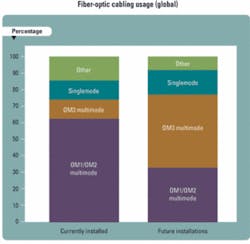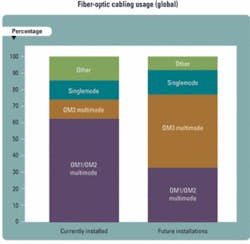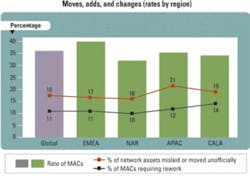Survey details switch to OM3 in enterprise
by Matt Brown
Predictions of exponential growth in bandwidth demand were common in the late 1990s. Now, with technology back on the rise, the communications industry is beginning to see those predictions realized. With the demand for individual user bandwidth increasing, the funneling effect of LAN switching is driving the need for more high-bandwidth fiber in the enterprise backbone.
To support bandwidth-intensive, real-time applications and to accommodate ever-increasing file size and traffic volume, IT managers are moving toward the higher performance offered by laser-optimized multimode optical fiber (OM3). According to research commissioned by SYSTIMAX Solutions, OM3 products are expected to become the dominant fiber type over the next 5 years, representing 43% of new installs in that period (see Figure 1). Conversely, use of OM1 and OM2 fiber is expected to be cut in half, from 63% in current installs to only 34% of new installs in that same time frame. The research, in which 1,484 IT professionals from around the world provided information on their requirements and strategies, not only details this evolution, but reveals some of the factors shaping cabling technology purchases in general.
To understand the appeal of OM3 fiber, it is helpful to have a basic understanding of all three grades of multimode fiber. OM1 is a legacy multimode fiber with a 62.5-µm core, which makes it a fundamentally lower-bandwidth fiber. This larger core allows greater modal dispersion, resulting in a typical peak bandwidth of 200 MHz•km. Because of its lower capacity, most OM1 installations today are upgrades and expansions of existing facilities that use 62.5-µm fiber.
OM2 fiber has a smaller, 50-µm core with less modal dispersion, giving the fiber a 950-MHz•km bandwidth capacity. OM3 improves on OM2. While it still has a 50-µm core, the core has been optimized for laser transmission. This optimized design removes, or at least significantly alleviates, manufactured flaws in the refractive index profile of the core and results in 2,000 MHz•km of bandwidth.
Some providers offer fiber that greatly exceeds the OM3 standard. Sometimes referred to as “OM3-plus,” such fiber has a higher information capacity (4,700 MHz•km) than any of the standard fiber grades.
As mentioned previously, the growth in bandwidth demand is the major driver for the increasing deployment of OM3 fiber. With business evolving in ways we never could have imagined just a few years ago, productivity tools and technologies like voice over IP (VoIP) and video collaboration are no longer seen only in movies or on Silicon Valley campuses. According to the SYSTIMAX Solutions survey, the number of corporate VoIP users has grown from 17% in 2002 to 43% in 2006. Similarly, video conferencing has gained traction as a cost-saving alternative to travel while workers are becoming increasingly mobile. One research firm predicts that the number of worldwide mobile workers will reach 878 million by 2009. It is clear that factors such as these, coupled with the overall increase in Internet traffic, are driving the increasing need for more bandwidth.
Also spurring the fiber evolution is the switch from Gigabit Ethernet to 10-Gigabit Ethernet (or higher) in the enterprise backbone. The research demonstrates this trend, showing that while 1 Gbit/sec is the predominant transmission requirement today, cabling to support 10 Gbits/sec and higher is expected to grow from the 16% of installations today to 80% of new installs in the next 5 years. OM3 fiber supports extended gigabit drive distances, allowing companies more flexibility in Gigabit Ethernet systems and paving the way for 10-Gbit/sec and higher-speed Ethernet. This feature promotes the use of the higher-performance fiber in the backbone.However, raw bandwidth is not the only reason that more managers expect to install OM3. Another driving factor for the adoption of OM3 fiber is the total cost of ownership. Cabling is only a small fraction of the cost of building a LAN or information network since PCs, servers, software, and storage devices make up the bulk of the costs. Server and software upgrades continue to create additional costs throughout the life of the network, further reducing the effective cost for the cabling infrastructure over the lifetime of the facility.
In addition, network managers who wish to provide a reliable, adaptable network to support their organization’s future bandwidth needs tend to invest in high-quality fiber cabling that will last for the next 20 years. Since upgrading the cable infrastructure can be a very painful process that can result in many hours of downtime and lost productivity, IT managers have a strong incentive to move sooner rather than later toward the headroom provided by high-bandwidth OM3 and OM3-plus fiber.
The research report also highlighted the higher rate of moves, adds, and changes (MACs) associated with an increasingly mobile workforce. Users reported an average MAC rate of 36%/year (up from 14% in 1994 and 23% in 2004; see Figure 2), costing 1.9 hr per MAC when a user changes location. Europe and the Middle East had the highest MAC rate at 40%/year. In Asia, users have even reported spending a half day or longer per MAC. High rates of MACs emphasize the need for enterprise structured cabling to be highly adaptable so that it can more easily support reconfiguration.The same need for network adaptability and control that drives structured cabling has led to the rise of real-time infrastructure management (RTIM) offerings. These systems offer data network managers interactive, real-time control over fiber connections. The results are more responsive network administration and better security. Such systems also cut running costs by automating routine management tasks and assisting technicians in completing work orders and service provisioning.
Structured cabling is designed and installed independently from the equipment it serves so that it can support multiple applications over its lifecycle. To accomplish this, it is designed to connect work areas to telecommunications rooms, which streamlines centralized MACs at the horizontal crossconnect. This design permits any equipment or service to be attached to the horizontal cabling based on the needs of the organization.
The research report also shows that product quality is the single most important factor companies consider when making a cabling investment choice. This is reflected in the increasing number of enterprises that are choosing factory-terminated, modular cabling. This type of cabling has a significant quality and reliability advantage since all the fiber termination and polishing occurs in a quality-controlled factory environment. The product ships with test reports attached, making it a known quantity for the installers and IT managers who will depend on it. Not surprisingly, the report shows that companies that listed initial cost, instead of quality, as their primary decision factor had the highest reported network downtime.
Bandwidth needs caused by large applications and mobile workers are leading to the widespread adoption of OM3 fiber, which in turn is driving a need for structured cabling and patching. Companies that make the investment in OM3, modular cabling infrastructure, and RTIM systems should experience less downtime and increased productivity. These OM3 technologies will support a company’s bandwidth needs well into the future, making this a bandwagon enterprise networks should consider joining.Matt Brown is the manager for CommScope’s fiber-optic apparatus (www.commscope.com). Brown has more than 12 years of experience in fiber optics, including cable manufacturing, multifiber connector design, and management of test equipment and connectivity products. He has also authored several industry standards within TIA FO-4 and TR-42, and is a United States National Committee expert to the International Electrotechnical Commission (IEC).


